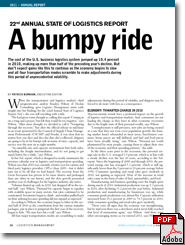2011 State of Logistics: Less-than-truckload
Time to cash in on rates?
Latest Material Handling News
Less-than-truckload (LTL) trucking has been less than profitable for many of the top carriers in this $27.5 billion sector that has been plagued by overcapacity, high overhead costs, and staggering losses from its largest players.
The parent companies of the two largest national, unionized LTL carriers—YRC Worldwide and Arkansas Best Corp.—continue to bleed red ink even as the national economy and U.S. manufacturing sector recovers from the worst recession in 70 years.
YRC has lost in excess of $2.7 billion the last four years, including $102 million in the first quarter this year. Its chief rival, ABF Freight System, contributed to a $12.8 million loss to its parent company in the first quarter, on top of $158 million in losses the two previous years.
“We see evidence that the economy, though not increasing as quickly as we would have hoped, still is growing,” outgoing YRC Chairman and CEO Bill Zollars said when releasing his company’s first quarter financial report. “The economy is soaking up the excess capacity.”
Analysts estimate that there still could be as much as 15 percent excess capacity in the LTL sector. That would be roughly the amount of capacity operated by YRC’s national and regional units. Some analysts, including David Ross of Stifel Nicolaus, are predicting that YRC could run out of sufficient cash by the middle of next year unless there is a surge in freight demand and rates rise dramatically.
|
|
|
|
Visit the 2011 Quest for Quatlity Winners NATIONAL LTL | REGIONAL LTL | TRUCKLOAD | RAIL |
 home page |
|
|
|
Zollars and other YRC officials scoff at such predictions, and insist their financial restructuring is on target.
The YRC national and regional carriers endured the worst pricing yields in the LTL industry, according to figures compiled by Stifel Nicolaus. While sector leader Old Dominion Freight Line—the only publicly held LTL carrier with an operating ratio as low as 91—enjoyed more than 11 percent year-over-year yield improvement in the first quarter of this year, the YRC units and ABF could manage yield improvements of barely 2 percent year-over-year. Zollars recently told analysts and investors that would change soon.
Zollars said YRC is getting pickier on its accounts and said the days of rock-bottom LTL rates, circa 2007-2010, are over. “It’s always a judgment call. Every account is different,” he said. “We think we are making good decisions around volume and price.”
Most of the LTL carriers are in the same boat on pricing as YRC, although not suffering nearly the level of losses. Except for Old Dominion, most of the other leading LTLs had lackluster first quarter figures. UPS Freight had an operating ratio of around 100, ABF was a 105.6, and Vitran was at 99.4. Through strong cost controls, Con-way reported a 97.3 operating ratio, its best quarter since the recession began, according to their financial reports.
Con-way’s operation could be a harbinger for the sector. Its year-over-year improvement in the first quarter was because of a conscious decision by top management to jettison some unprofitable accounts. Con-way and other carriers are getting tougher and insisting on full freight surcharges, which are currently running about 22 percent to 24 percent in the LTL space.
In the LTL industry, the mantra for profitability remains freight density, cost control, and pricing discipline. If LTL carriers can understand their costs, they can price business to earn an appropriate return.
Carrier executives say privately that the time to gain solid returns is now. That’s because once pricing is firm and established and adequate returns are assured, then carriers can benefit from additional volumes by being able to leverage their network density. This occurs when freight demand is robust, which historically has been in the late second, third, and early fourth quarters of a calendar year. In other words, the future is now.

Article Topics
Features News & Resources
Latest in Materials Handling
Beckhoff USA opens new office in Austin, Texas Manhattan Associates selects TeamViewer as partner for warehouse vision picking ASME Foundation wins grant for technical workforce development The (Not So) Secret Weapons: How Key Cabinets and Asset Management Lockers Are Changing Supply Chain Operations MODEX C-Suite Interview with Harold Vanasse: The perfect blend of automation and sustainability Consultant and industry leader John M. Hill passes on at age 86 Registration open for Pack Expo International 2024 More Materials HandlingSubscribe to Materials Handling Magazine

Find out what the world's most innovative companies are doing to improve productivity in their plants and distribution centers.
Start your FREE subscription today.
April 2024 Modern Materials Handling

Latest Resources











